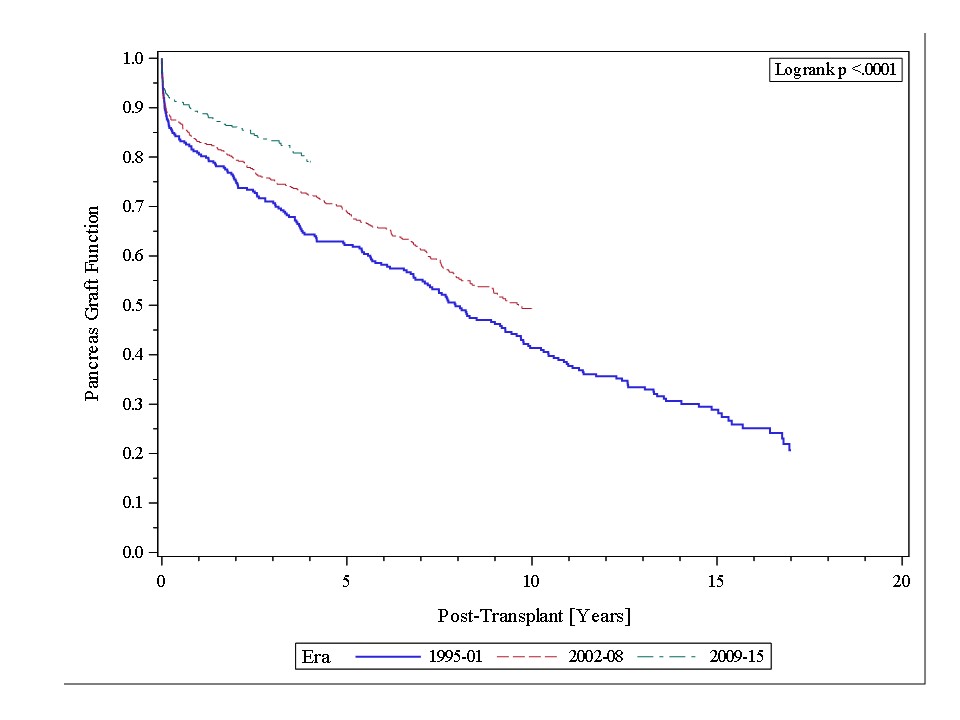Simultaneous Pancreas and Kidney Transplant (SPK) – The New Standard of Care for Uremic Patients with Type 2 Diabetes Mellitus (T2DM).
Surgery, SUNY Upstate Medical University, Syracuse, NY
Meeting: 2017 American Transplant Congress
Abstract number: C210
Keywords: Kidney/pancreas transplantation, Outcome, Risk factors
Session Information
Session Name: Poster Session C: Pancreas and Islet (Auto and Allo) Transplantation
Session Type: Poster Session
Date: Monday, May 1, 2017
Session Time: 6:00pm-7:00pm
 Presentation Time: 6:00pm-7:00pm
Presentation Time: 6:00pm-7:00pm
Location: Hall D1
Introduction: While a SPK is now considered standard of care for uremic T1 DM patients, it is not for T2DM (despite similar medical issues). The purpose of this analysis was to study current SPK outcome in T2DM.
Methods: Between 1995 and 2015, 1,514 primary deceased donor pancreas transplants in patients with T2DM were reported to IPTR/UNOS. The majority of transplants were SPK (88%). Comprehensive statistical analyses were performed using recipient, donor and technical factors.
Results: In contrast to T1DM, the number of primary SPK in T2DM increased over time. Table 1 shows the distribution for the most important characteristics.
| Era | 1995-01 | 2002-08 | 2009-15 | p |
| N | 298 | 482 | 542 | <0.0001 |
| Age | 44(8) | 48(8) | 46(8) | <0.0001 |
| %AfricanAmerican | 14 | 23 | 32 | <0.0001 |
| %BMI > 28kg/m2 | 19 | 31 | 32 | 0.0003 |
| % on Dialysis | 83 | 84 | 89 | 0.03 |
Improvement over time was noted for SPK patient survival (p<0.0001): at 3-years, from 96.2% to 98.6%. Risk factors for patient survival were a failed pancreas and/or kidney graft, age over 45 years, and being African American.
Pancreas [Figure 1] and kidney graft function also improved significantly over time (p<0.0001). The rate of technical failures decreased from 8.4% to 5.7% (p>0.05).  The main reason for pancreas as well as kidney graft failure was dying with a functioning graft (> 40% of all causes for graft failure). Recurrence of T2DM was rarely noted (<1% of failures) and only in patients with massive posttx weight gain. Donor age > 30 years of age was the most influential risk factor for technical complications and pancreas graft failure. Maintenance immunosuppression with Tacrolimus in combination with MMF improved graft function.
The main reason for pancreas as well as kidney graft failure was dying with a functioning graft (> 40% of all causes for graft failure). Recurrence of T2DM was rarely noted (<1% of failures) and only in patients with massive posttx weight gain. Donor age > 30 years of age was the most influential risk factor for technical complications and pancreas graft failure. Maintenance immunosuppression with Tacrolimus in combination with MMF improved graft function.
Conclusion: Patient and graft outcomes after SPK in T2DM have significantly improved over time. As in T1DM, SPK should also be considered standard of care for insulin-dependent, uremic T2 diabetics with the caveat that weight gain has to be avoided after transplant.
CITATION INFORMATION: Gruessner A, Laftavi M, Whittaker V, Acun Z, Pankowycz O, Gruessner R. Simultaneous Pancreas and Kidney Transplant (SPK) – The New Standard of Care for Uremic Patients with Type 2 Diabetes Mellitus (T2DM). Am J Transplant. 2017;17 (suppl 3).
To cite this abstract in AMA style:
Gruessner A, Laftavi M, Whittaker V, Acun Z, Pankowycz O, Gruessner R. Simultaneous Pancreas and Kidney Transplant (SPK) – The New Standard of Care for Uremic Patients with Type 2 Diabetes Mellitus (T2DM). [abstract]. Am J Transplant. 2017; 17 (suppl 3). https://atcmeetingabstracts.com/abstract/simultaneous-pancreas-and-kidney-transplant-spk-the-new-standard-of-care-for-uremic-patients-with-type-2-diabetes-mellitus-t2dm/. Accessed January 8, 2026.« Back to 2017 American Transplant Congress
